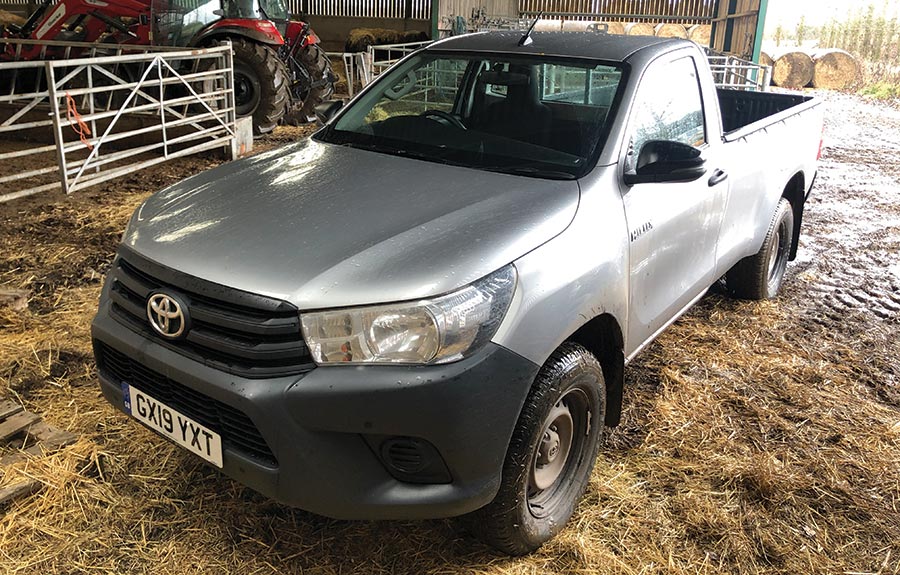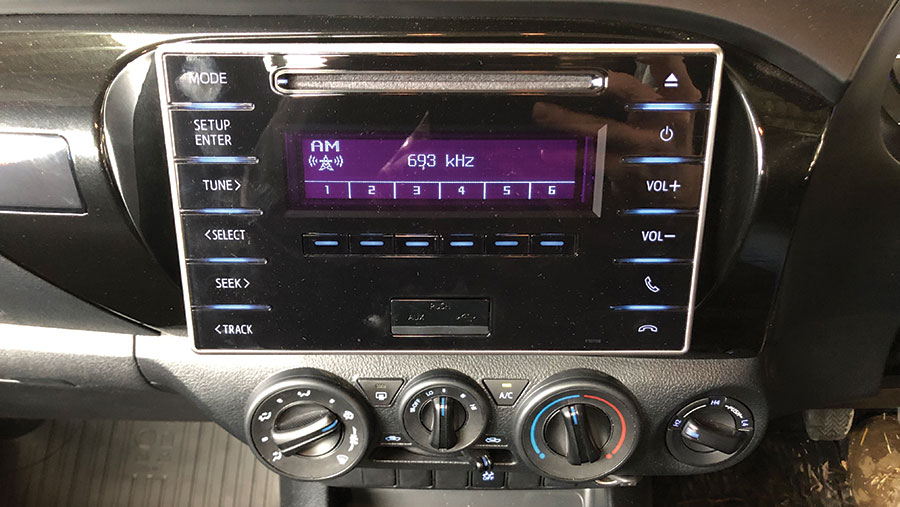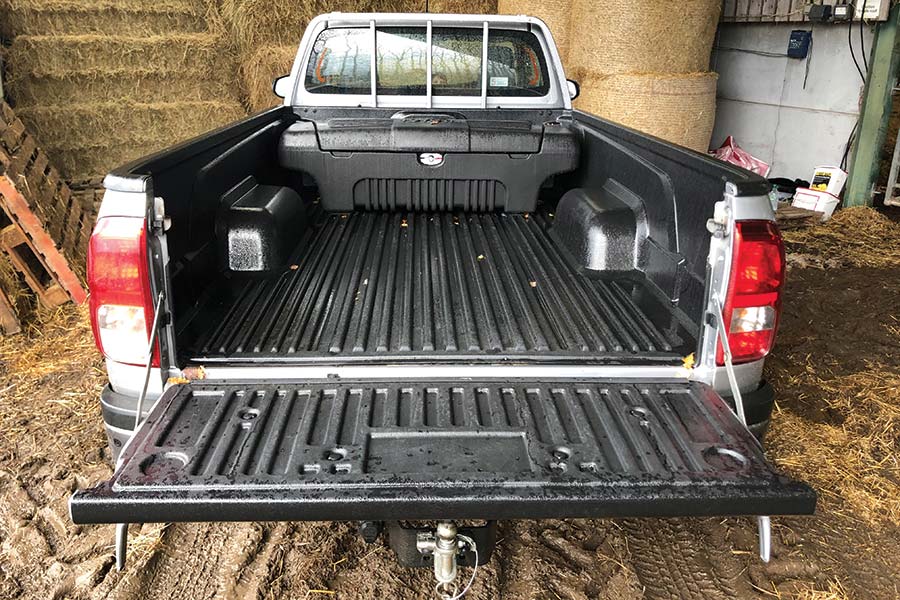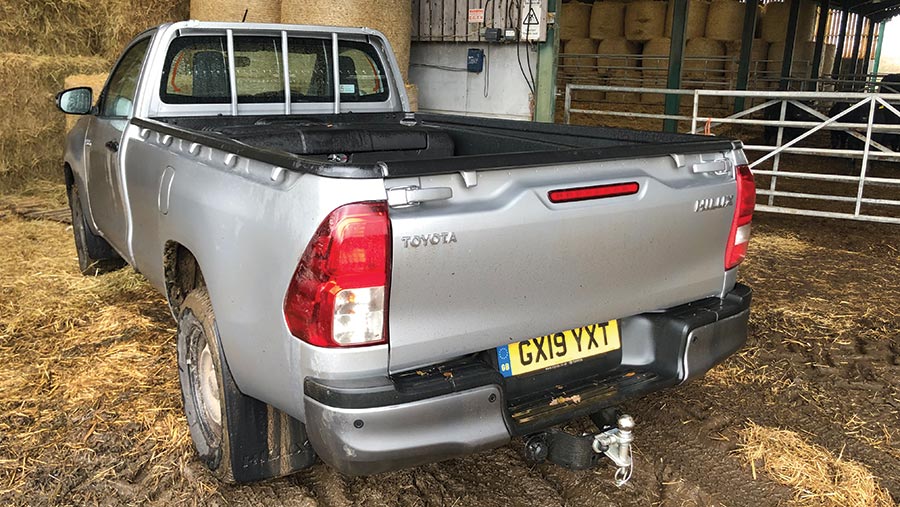Pickup test: Toyota Hilux Active

There is little doubt that budget Hilux models are well made and reliable workhorses.
Tidily laid out controls and a comfortable drive make it a particularly appealing option at this price point, as do the decent payload and towing ratings.
There are also stacks of driver assist systems included, but they can do nothing to improve the clumsy turning circle and unremarkable fuel economy.
The big catch is that it only came in under our £22,000 budget in single cab format, though the £2,000 hop from this model to the cheapest double cab won’t be bank breaking.
See also: High-hour Horsepower: Toyota Land Cruiser hits 484,000 miles
Vital stats
- Engine 2.4-litre
- Power 148hp@3,400rpm
- Torque 400Nm@1,600-2,000rpm
- Transmission Six-speed manual
- Weight 1,850kg
- Payload 1,105kg
- Towing capacity 3,500kg
- Turning circle 12.6m
- Price £20,502
Engine and transmission
All Hilux pickups come with the same 2.4-litre four-cylinder engine and the block feels a more natural match for the entry-level models, where the odd agricultural-sounding grumble is pretty inoffensive.
It can get a bit noisy when accelerating in “power” mode, but doesn’t shout quite as loudly as Isuzu’s small-bored D-Max.
To calm things, throttle response can be dialled down to a meeker “eco” setting, which reduces power and helps to balance the heating and cooling of the engine to improve fuel economy. However, it does cause the pickup to feel a bit gutless.
Toyota only offers its manual gearbox in Active spec models, but that shouldn’t cause too much upset for potential buyers.
We tested the automatic version two years ago and its dilly-dallying between gears and generally slow shifting means it’s not a great miss.

Our experiences also suggest that the manual transmission is slightly more frugal.
The Invincible automatic recorded an unimpressive 28.44mpg over our test route, while the manual chalked a marginally more respectable 30.3mpg.
That said, there’s still a seismic gap to the 39.8mpg Toyota quotes in its brochures.
The rear leaf suspension – geared up to handle a maximum 1,105kg payload – sees the Hilux struggle to iron out small bumps on country lanes, especially when empty.
Unfortunately, this is much more noticeable in a single cab and contributes to a fairly unsettled ride at low speeds.
Our test model’s clutch biting point was also a touch on the high side and took some getting used to.
Interior
The single cab configuration means there is a distinct lack of dry storage, especially when both seats are occupied.
Those that travel with spanners and other workshop gear will struggle to avoid either building or buying a loadbed box (more on this later).
The interior finish is smart, with solid, workmanlike materials used throughout – doors are heavy, cloth seats are comfy and controls are easy to use, demonstrating Toyota’s ability to resist scrimping in key areas.

In fact, the firm’s base-spec generosity extends to heated door mirrors, all-round parking sensors and auto headlights, giving the Hilux a plush edge that some of its rivals are lacking. The D-Max looks particularly spartan by comparison.
The central screen hardware is the same as top-end Invincible models, but get up close and you will realise that most of the functions on the tablet-style touchscreen have disappeared and it’s actually just a display readout.

That said, connecting a smartphone remains easy, as does playing music wirelessly.
Steering wheel buttons offer telephone and radio controls and there are readouts for mpg and trips displayed between the dash dials.
Towing and off-road
Single cab models get the same 3.5t towing capacity as the rest of the Toyota range.
Added to that, the engine’s peak 400Nm torque arrives at just 1,600rpm, which undoubtedly helps acceleration with a heavy load.
There are also various haulage-helping extras, such as trailer sway control.

This automatically detects excessive movement of the trailer and selectively applies brake pressure to individual wheels and reduces engine torque to bring it back under control.
A slip indicator light on the dash flashes to indicate that it’s working.
Hill hold assist is also included – it maintains the brake force for up to 5sec after the brake pedal is released to prevent rolling back on steep inclines.
The four-wheel drive system is pretty run of the mill, with H2, H4 and L4.
The truck has to come to a stop to engage the low range and only then can the rear differential lock be activated by a button on the dash.
Our model was also fitted with 265/65 R17 Bridgestone Duellers on optional black steel wheels, which helps lift the budget appearance up a notch.
And we had a big lockable storage box bolted in the load bed, providing extra space to store valuables.
At £287.70, it seems pretty reasonably priced by pickup accessory standards.
Of course, the major perk of the single cab setup is the football-pitch-sized load bed.

At more than 2.3m long – 800mm longer than that of the double cab – it provides plenty of space, even with storage boxes on board.
The bed has an external rail on either side for strapping and a ladder across the back of the cab for longer items to rest without damaging the roof.
However, the test truck had no internal points for strapping smaller items down.
Other spec details worth considering are the clumsy turning circle – at 12.6m, it is 80cm bigger than the L200 – and decent ground clearance.
Likes
- Best build quality
- Lots of driver assist systems included
- External tie down lugs and ladder above cab
- Good ground clearance
Gripes
- Fuel economy pretty poor
- Jittery on country roads
- High clutch biting point
- Clumsy turning circle
Rest of the range
The 2.4-litre engine is used across in all of Toyota’s pickups.
The base spec is Active and these models are only available with a manual transmission, in single- and double-cab variants.
Next up is the Icon spec, with its double cab and colour-coded bumpers, and a smattering of chrome on mirrors and door handles, setting it apart from the base models. However, it comes in about £4,000 more expensive.
The top two models are the Invincible and Invincible X, with the latter getting the revised front grille and latest styling.
Extras here range from satnav to smart entry and push button start.
Fully kitted out, an Invincible X pushes past the £40,000 mark.

